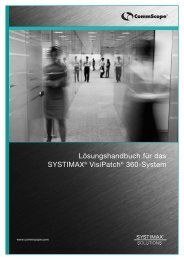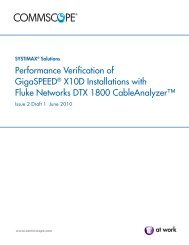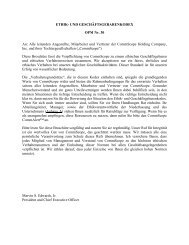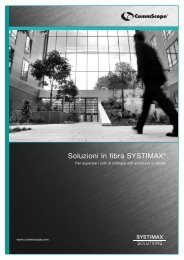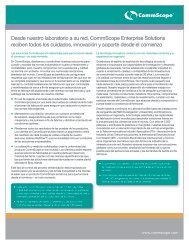Active Antennas: The Next Step in Radio and Antenna Evolution
Active Antennas: The Next Step in Radio and Antenna Evolution
Active Antennas: The Next Step in Radio and Antenna Evolution
Create successful ePaper yourself
Turn your PDF publications into a flip-book with our unique Google optimized e-Paper software.
4 AAS BENEFITS<br />
<strong>The</strong> benefits of an active antenna architecture over an RRH based site architecture are many. First,<br />
there is a potential to significantly reduce the site footpr<strong>in</strong>t. Second, the distribution of radio<br />
functions with<strong>in</strong> the antenna results <strong>in</strong> built-<strong>in</strong> redundancy <strong>and</strong> improved thermal performance,<br />
which can result <strong>in</strong> higher system availability (lower failure rates). Third, distributed transceivers can<br />
support a host of advanced electronic beam-tilt features that can enable improvements <strong>in</strong> network<br />
capacity <strong>and</strong> coverage; hence, it has the potential to lower capital <strong>and</strong> operational costs. Each of<br />
these features shall now be described <strong>in</strong> the follow<strong>in</strong>g sections.<br />
4.1 Site Footpr<strong>in</strong>t<br />
<strong>The</strong> first obvious benefit with the <strong>in</strong>tegration of the radio with<strong>in</strong> the antenna is the elim<strong>in</strong>ation of<br />
several components like cables, connectors, <strong>and</strong> mount<strong>in</strong>g hardware <strong>and</strong> an overall reduction <strong>in</strong> the<br />
physical tower space required. By <strong>in</strong>tegrat<strong>in</strong>g the remote radio head functionality <strong>in</strong>to the antenna,<br />
the aesthetics of the site can be improved <strong>and</strong> w<strong>in</strong>d load reduced. <strong>The</strong> follow<strong>in</strong>g table compares the<br />
hardware required for a three sector BTS us<strong>in</strong>g an RRH-based solution with an <strong>Active</strong> <strong>Antenna</strong><br />
System (AAS). As can be seen from the table, there is a significant reduction <strong>in</strong> the number of<br />
components <strong>in</strong> an AAS.<br />
RRH + Passive <strong>Antenna</strong> <strong>Active</strong> <strong>Antenna</strong><br />
High Power RF Cables 6 -<br />
Mount<strong>in</strong>g Brackets 6 3<br />
RET Controller 3 -<br />
Table 1: Typical components <strong>in</strong> a three-sector, s<strong>in</strong>gle-b<strong>and</strong>, cell site.<br />
In addition to the cost benefits due to reduction <strong>in</strong> the number of components, further sav<strong>in</strong>gs can<br />
be potentially achieved with lower tower leas<strong>in</strong>g costs <strong>and</strong> lower <strong>in</strong>stallation costs.<br />
4.2 Improved System Availability<br />
Due to its <strong>in</strong>herent architecture, an AAS can offer significant improvements <strong>in</strong> system availability<br />
over an RRH based system. <strong>The</strong> <strong>in</strong>crease comes about because of two factors:<br />
i) Improved thermal marg<strong>in</strong><br />
<strong>The</strong> active antenna architecture can elim<strong>in</strong>ate a substantial portion of the power losses <strong>in</strong> the RF<br />
feeder cables when compared to a conventional BTS. Though an RRH can provide a similar benefit,<br />
the AAS goes further by elim<strong>in</strong>at<strong>in</strong>g the need for even a short jumper cable between the RRH<br />
output <strong>and</strong> the antenna. Additionally, the active antenna can support an electronic beam tilt without<br />
requir<strong>in</strong>g a Remote Electrical Tilt (RET) feeder network. This further reduces the power loss for an<br />
AAS when compared to an RRH with a RET. In most configurations this can <strong>in</strong>crease the power<br />
delivered to the antenna when compared with an RRH. <strong>The</strong> additional marg<strong>in</strong> can be used to lower<br />
the overall thermal dissipation <strong>in</strong> the amplifiers.<br />
Further, with the radios <strong>in</strong>tegrated directly <strong>in</strong>to the antenna hous<strong>in</strong>g, <strong>and</strong> with replacement of a small<br />
number of large amplifiers with many small amplifiers, the heat is spread over the larger antenna<br />
structure as opposed to the smaller RRH or amplifier shelf. This availability of higher surface area<br />
for heat dissipation results lower temperature rises <strong>in</strong> the components, which results <strong>in</strong> improved<br />
thermal marg<strong>in</strong>s <strong>and</strong> better reliability.<br />
WP-105435-EN (10/11) 6



